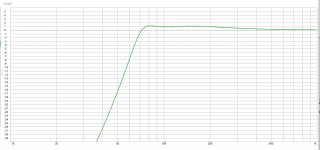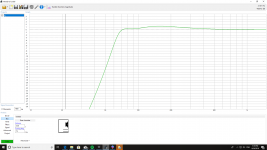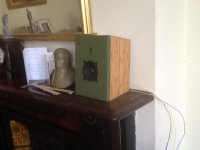I've just looked at what a 3FE25 would look like in your cabinet. I presume that with the extra panels, driver and port it would be about 2.75 litres in volume.
The port is at 78hz / 72mm long.
Gives the same rise you mentioned which would help with BSC.

Not the best roll off but would be ok when crossover.
The port is at 78hz / 72mm long.
Gives the same rise you mentioned which would help with BSC.

Not the best roll off but would be ok when crossover.
Last edited:
I am having a hard time visualizing this. Can you send a photo..It's far better to just put two pieces of dense open cell foam on each side of the driver, leaving a vertical ca. one inch opening. Experiment with thickness and spread.
This will attenuate some of the highs and works as a non resonant acoustic lens, improving the axial response in the highs.
A sharp peak like the one around 12 Khz like with this driver looks like simple but temperamental uncontrolled breakup.
This is cured very well by foam, when it's this high.
Oon
I am having a hard time visualizing this. Can you send a photo..
Oon
No need. It's just a vertical slot with the sides made of foam.
Just like slots in front of some tweeters.
No need. It's just a vertical slot with the sides made of foam.
Just like slots in front of some tweeters.
Surely that would change the off axis response?
It's far better to just put two pieces of dense open cell foam on each side of the driver, leaving a vertical ca. one inch opening. Experiment with thickness and spread.
This will attenuate some of the highs and works as a non resonant acoustic lens, improving the axial response in the highs.
A sharp peak like the one around 12 Khz like with this driver looks like simple but temperamental uncontrolled breakup.
This is cured very well by foam, when it's this high.
I'd like more info on this too please. I've thinking about using foam/felt etc as some kind of mechanical crossover filter in a 1.5 way?
I'd be happy to try it. I've haven't had much luck in the past with acoustic filters, but this sounds simple enough.It's far better to just put two pieces of dense open cell foam on each side of the driver, leaving a vertical ca. one inch opening. Experiment with thickness and spread.
What I don't understand is how foam covering the edges helps attenuate the highs in the center. You mention a lens. Is the foam bending or spreading the shorter wavelengths?
I have used the Variera bamboo box with the 3fe 25. Fantastic performance, ease of construction, WAF, cheapness. It is a bit lively at the top end perhaps. The tilt of the box makes it perfect for desktop use.
I am impressed with your recessed baffle. Very smart. How did you do it with the non parallel sides?.
I simply plonked the baffle on the front, because the edges of the box are flat wrt the baffle. It also maximised the volume (about 4.2 litres gross from memory) making it about right for the 3fe25. I also damped the panels with bitumous sheet. The holes at the back are perfect for the binding posts I had.
I am impressed with your recessed baffle. Very smart. How did you do it with the non parallel sides?.
I simply plonked the baffle on the front, because the edges of the box are flat wrt the baffle. It also maximised the volume (about 4.2 litres gross from memory) making it about right for the 3fe25. I also damped the panels with bitumous sheet. The holes at the back are perfect for the binding posts I had.
Attachments
Surely that would change the off axis response?
That is the whole point.
Dips, peaks and off axis response in FR drivers is almost always closely linked.
I'd be happy to try it. I've haven't had much luck in the past with acoustic filters, but this sounds simple enough.
What I don't understand is how foam covering the edges helps attenuate the highs in the center. You mention a lens. Is the foam bending or spreading the shorter wavelengths?
It's much like the Karlson lens minus the resonance and horn loading features.
Slot lenses for fullrange and midrange is an old idea. Often made of more rigid materials, perhaps to add a bit of loading too, and in all kinds of shapes: Lemon, vertical divide sign, double mirrored Karlson slot, etc.
Trouble with rigid lenses is that they almost always add additional resonance.
Not so with foam, or at least it's minimal.
It's just like a pinhole optical lens only stretched like a cats pupil.
The variation in the highs of an FR driver is the result of additive and destructive interference both in the cone and in the air.
The foam is not a perfect cure, but it will work as combined lowpass filter and lens that will among other things make the driver appear to be a skinny and tall tweeter.
Thanks - I was hoping you would say that because that's what I was thinking. Always happy when I get it right.The variation in the highs of an FR driver is the result of additive and destructive interference both in the cone and in the air.
I have used the Variera bamboo box with the 3fe 25. Fantastic performance, ease of construction, WAF, cheapness. It is a bit lively at the top end perhaps. The tilt of the box makes it perfect for desktop use.
I am impressed with your recessed baffle. Very smart. How did you do it with the non parallel sides?.
I simply plonked the baffle on the front, because the edges of the box are flat wrt the baffle. It also maximised the volume (about 4.2 litres gross from memory) making it about right for the 3fe25. I also damped the panels with bitumous sheet. The holes at the back are perfect for the binding posts I had.
Thanks for the compliment if you look at my initial posts pictures....the one without the baffle fitted... you may see that I just lined the box with plywood (and. Bitumen and wool). So creating a shelf for the baffle to sit on. The black lip is it......I added an expanded foam gasket on top of the end on plywood.
The baffle is quite thin so the effect of the non parallel walls is lessened....but I did knock the back corner off the baffle edges to allow a reasonably tight fit at the face. I cut it a little large and sanded to fit.
I am trying to learn about baffle diffraction....mounting the drivers flush or surface...and also the baffle placement. My recessed baffle may have good WAF factor but I don't think the guys with measuring equipment will share my design....i think it is not optimal from an SQ point of view.
I am considering filling in the baffle recess with hard felt...obviously cutting out for the driver and port.
Last edited:
It has sufficient bass gain that BSC is not needed. In a regular bass reflex box typically I use 1mH and 4ohms to 6.8ohms as BSC to even things out.
Do these values stand for an 8ohm driver.?
I put in my values into the forum bsc calculator....8ohm driver, 6" wide baffle and 10db attenuation as that is the rise in response of these things at the top end. It came out with 760hz fs, 3.6Mh and 17.3ohm . Sound like a starting point?
Edit...putting in 6db gives 1.7mH and 8 ohms
Last edited:
Little update
So I am really enjoying these little speakers. Even with the makeshift enclosures. I have repositioned my REL quake subwoofer and it all integrates very nicely.
I have two means of playing through them. One using my Denon Avr as pre amp so I get to use the XO to roll them off at 150Hz. This obviously helps them to play quite loud. But the AVR does harm the SQ a bit. Other way is though a DAC and passive preamp so they are getting all the low end. Sounds better but I have to watch what I play at what level.
I recently acquired a pair of Tang Band W3 871. Lovely things albeit I haven't powered them up yet.
I read the Vikash page where he made a lovely set of small speakers with this TB driver. He employed a notch filter and so in readiness I built this circuit and currently use it with the 3fe22. They have helped take the top end.
Here is the filter......oh wait....I can't upload the image from my phone....will update later.
I was going to ask what this circuit actually does!
Hang on....I can link to it....
Listening Impressions and Notch Filter for the W3-871S Fullrange Monitors
Page 3 shows the filter. Can anyone tell me what frequencies it is attenuation please?
0.7mh, 3.3uF, 6.8R
So I am really enjoying these little speakers. Even with the makeshift enclosures. I have repositioned my REL quake subwoofer and it all integrates very nicely.
I have two means of playing through them. One using my Denon Avr as pre amp so I get to use the XO to roll them off at 150Hz. This obviously helps them to play quite loud. But the AVR does harm the SQ a bit. Other way is though a DAC and passive preamp so they are getting all the low end. Sounds better but I have to watch what I play at what level.
I recently acquired a pair of Tang Band W3 871. Lovely things albeit I haven't powered them up yet.
I read the Vikash page where he made a lovely set of small speakers with this TB driver. He employed a notch filter and so in readiness I built this circuit and currently use it with the 3fe22. They have helped take the top end.
Here is the filter......oh wait....I can't upload the image from my phone....will update later.
I was going to ask what this circuit actually does!
Hang on....I can link to it....
Listening Impressions and Notch Filter for the W3-871S Fullrange Monitors
Page 3 shows the filter. Can anyone tell me what frequencies it is attenuation please?
0.7mh, 3.3uF, 6.8R
- Status
- This old topic is closed. If you want to reopen this topic, contact a moderator using the "Report Post" button.
- Home
- Loudspeakers
- Full Range
- Ikea Variara full range with Faital Pro 3fe22

